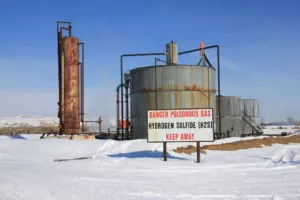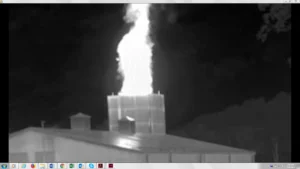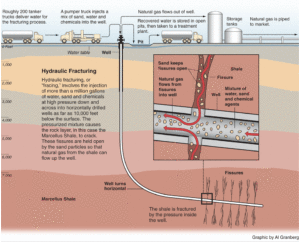Oil and gas chemicals enter the environment via several pathways:
The Drilling Process
Drilling involves the use of muds to keep the drill bit cool and lift the rock cuttings out of the well bore. Muds may be water-based, oil-based or synthetic. They typically contain bentonite clay (or a synthetic polymer substitute), as well as other chemical additives that alter the mud properties (thickness, weight, bacteria proliferation, etc.).
Releases of drilling muds and additives to the environment can occur at the well site (spills, leaks from drilling reserve and waste pits/tanks), or mud injected underground can move through formations and contaminate surface or groundwaters.
Hydraulic Fracturing
Hydraulic fracturing ‘fracking’ is a method of stimulating oil and gas wells. Typically, it involves pumping hundreds of thousands of gallons of fluids and sand into the oil or gas formation. At a certain point, the formation will crack open. Studies have found that anywhere between 25 and 82% of the fluids will return to the surface, but some chemicals are preferentially trapped in the formation. At the surface, the flowback fluids are held in pits or tanks prior to disposal. The sand is left in the formation to hold open the fractures, thus creating larger pathways for the hydrocarbons to flow to the well.
According to data from the Environmental Protection Agency, fracking fluids may contain a number of chemicals that are hazardous to human health.
There are numerous potential pathways for contamination of water and air by fracking fluids.
- The most direct connection is if fracking fluids are injected directly into rock formations that also serve as freshwater aquifers and underground sources of drinking water. According to EPA, there are coalbed methane formations that undergo hydraulic fracturing, but also serve as freshwater aquifers.
- Fracking chemicals have the potential to migrate, as liquids or gases, from leaky wellbores into adjacent groundwater aquifers. There is the possibility for migration may occur, as well, through vertical and horizontal fractures into groundwater or even to surface water.
- Even if the fracking chemicals, themselves, do not migrate into groundwater, the hydraulic fracturing operation may change the underground geology in such a way that new pathways are formed that allow hydrocarbons such as methane, and benzene, to migrate away from their original location. Fracturing, which causes mini-seismic events under ground, may also introduce more sediment into groundwater aquifers, changing the water quality temporarily, or possibly permanently.
- A final pathway for contamination is if fracking fluids are spilled onto the ground or into waterways. Spills may be of unused fracking chemicals, or used fracking fluids that flow back out of the well after it has been hydraulically fractures. Any volatile compounds in spilled fracking fluids may enter the air and be carried downwind.
Waste Pits and Tanks
A significant portion of the chemicals injected underground during drilling, hydraulic fracturing or well maintenance return to the surface, where they are stored, at least temporarily, in open pits or tanks. Produced water may also be stored in pits or tanks prior to permanent disposal (e.g., injection into a deep aquifer; discharge to streams). In some cases, produced water is left in open pits to evaporate.
According to an Argonne National Laboratory white paper, produced water contains many organic and inorganic compounds that can lead to toxicity. Naturally occurring contaminants include salts, which can be toxic to plants at high concentrations; hydrocarbons from the oil- or gas-bearing formations; metals, which may be naturally present in the deep groundwater; and naturally occurring radioactive materials (NORM).
A variety of treatment chemicals and additives may be present in produced water. Some of these chemicals can be lethal at levels as low as 0.1 parts per million.
- The treatment chemicals used for gas processing typically include dehydration chemicals, hydrogen sulfide-removal chemicals, and chemicals to inhibit hydrates. Well-stimulation chemicals that may be found in produced water from gas operations can include mineral acids, dense brines, and additives.
- For oil production, treatment chemicals are typically complex mixtures of various molecular compounds. These mixtures can include: corrosion inhibitors and oxygen scavengers to reduce equipment corrosion; scale inhibitors to limit mineral scale deposits; biocides to mitigate bacterial fouling; emulsion breakers and clarifiers to break water-in-oil emulsions and reverse breakers to break oil-in-water emulsions; coagulants, flocculants, and clarifiers to remove solids; and solvents to reduce paraffin deposits.
In Colorado, not all pits are lined, presenting the potential for liquid wastes to seep into soil and groundwater. Both lined pits and steel tanks may also cause contamination through leaks and overflow. Find out more about pits.
Another pathway for exposure to chemicals from waste pits is through volatilization of chemicals sitting in the pits. For example, benzene and other volatile (light) hydrocarbons that are dissolved in liquids will enter the air when the liquid is exposed to the atmosphere.
Spills
Spills and leaks of raw chemicals or oil and gas wastes may affect land, water and air. In Colorado, the Colorado Oil and Gas Conservation Commission (COGCC) requires companies to report spills of fluids related to any unauthorized release of exploration and production (E&P) wastes that are 5 barrels or more in volume. In some cases, smaller spills are reported, e.g., if the spill enters surface or groundwater.
In the four-year period between June 2002 and June 2006, there were approximately 924 spills of oil and gas chemicals and wastes. Spilled products included: crude oil, condensate, produced water, and “other” products. The other products included diesel fuel, glycol, amine, lubricating oil, hydraulic fracturing fluids, drilling muds, other chemicals, and natural gas leaks.
Roughly estimated, 60% of the spills involved produced water; 34 % involved crude oil or condensate; and 12% involved spills of “other” substances. (Numbers add up to greater than 100% because some of the spills involved more than one type of fluid).
Of the 924 oil and gas industry spills, 20% of them contaminated water: 14% of the spills affected groundwater; and 6% of all spills affected surface water.
As the chart shows, a large percentage of spills recorded by the COGCC do find their way into groundwater or surface water.
While some of the spills are accidents, acts of nature (e.g., lightning strikes) there are many spills that are preventable. For example, during the four-year period, Chevron had 57 incidents of produced water and two crude oil leaks caused by corroded pipes or fittings. It is likely that proper maintenance, pipeline integrity testing, and replacement of old equipment could have prevented many of these spills.
We are continuing to analyze the COGCC’s spill data, so the spills report will be updated from time to time.
Toxic Air Releases
Venting and Fugitive Gas Emissions
The primary component of natural gas is methane, which is odorless when it comes out of the gas well. At gas processing facilities, chemical odorants such as mercaptans are added to methane, so that consumers are able to smell it in the event of a gas leak. People living next to natural gas wells, however, will not smell any methane released to the atmosphere through venting or fugitive emissions (leaks).
In addition to methane, natural gas typically contains other hydrocarbons such as ethane, propane, butane, and pentanes. Raw natural gas may also contain water vapor, hydrogen sulfide (H2S), carbon dioxide, helium, nitrogen, and other compounds.
Almost all references to the odor of raw or wellhead natural gas state that it, like methane, is odorless. The Ohio Department of Natural Resources, however, advises landowners that one way to detect an abandoned oil or gas well on their property is if they smell “natural gas” odors coming from their tap water. So, in some cases, there may be a slight hydrocarbon odor associated with venting of natural gas.
If the concentration of H2S in the gas is high enough, there may also be a “rotten egg” odor associated with the gas.
Condensate Fumes
Some natural gas wells produce a semi-liquid condensate along with the gas. Condensates are hydrocarbons that are in a gaseous state within the reservoir (prior to production), but become liquid during the production process. Condensates are composed of hydrocarbons (typically those containing five or more carbon molecules), as well as aromatic hydrocarbons such as benzene, toluene, xylenes and ethylbenzene (BTEX).
Condensates may give off a characteristic hydrocarbon or petroleum-type smell. BTEX give off a sweet, aromatic odor. Most people can smell benzene when it reaches levels of approximately 1.5 – 5 parts of benzene per million parts of air (ppm). The Occupational Safety and Health Administration (OSHA) has set maximum exposure levels for workers at 1 ppm (over an 8-hour period) and 5 ppm (over a 15-minute period). At levels above 150 ppm some people may begin to experience serious and irreversible health effects.
The vapors of benzene, toluene and xylenes are heavier than air and may accumulate in low-lying areas.
Odors from Waste Pits
Prior to disposal, drilling wastes (muds and cements), hydraulic fracturing (fracking) fluids and produced water are often stored in earthen or metal pits that are open to the air. There are hundreds of different chemicals that may be used during drilling, fracking and workover procedures, including acids, biocides, surfactants, solvents, lubricants and others. The odors associated with the chemicals will vary, depending on the concentrations, volumes, and combinations of chemicals used.
By-Products from Flaring
The by-products from burning natural gas vary depending on the composition of the gas and/or condensate being burned. There may also be additional by-products formed if some of the chemicals used during the drilling or hydraulic fracturing process are converted to a gaseous form and are burned along with the natural gas.
It is difficult to find information on the by-products of flaring specific to Colorado. The Ventura County Air Pollution Control District, in California, however, has estimated that the following air pollutants may be released from natural gas flares: benzene, formaldehyde, polycyclic aromatic hydrocarbons (PAHs, including naphthalene), acetaldehyde, acrolein, propylene, toluene, xylenes, ethyl benzene and hexane.
Glycol Dehydrator Emissions
If the gas wells use glycol dehydrators to remove water from the gas, you may be smelling some aromatic organic chemicals. Regeneration of the glycol solutions used for dehydrating natural gas can release significant quantities of benzene, toluene, ethylbenzene, and xylene, as well as a wide range of less toxic organics. As mentioned above, BTEX have a sweet chemical odor.
Diesel Fumes
Drilling, completion and workover trucks, rigs and equipment such as pumps typically run off of diesel-powered or gasoline engines. The exhaust fumes from gasoline and diesel fuels can produce emissions that are noticeable to people living downwind.
Polycyclic aromatic hydrocarbons (PAHs) are found in exhaust from motor vehicles and other gasoline and diesel engines. A long list of other air pollutants, including BTEX, formaldehyde and metals are also contained in diesel fuel combustion products.




